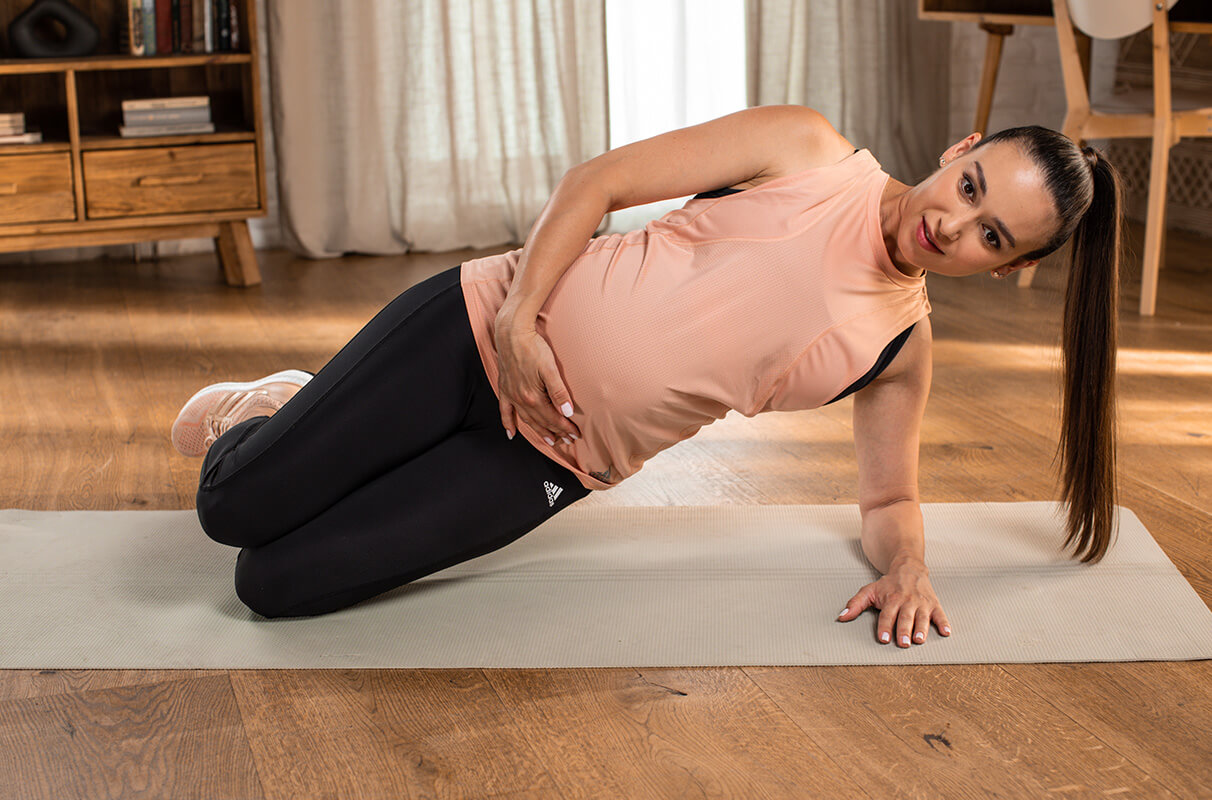Pregnancy brings with it many questions. While exercise is generally recommended during gestation, finding out exactly what exercises will benefit pregnant women can sometimes be daunting.
Here, you will find everything that you require:
Answers to frequently asked questions regarding safe pregnancy exercise (exercise). Specific trimester tips and other useful insights into prenatal workouts; Training plan examples in adidas Training App are also included here.
- Who Shouldn’t Exerte While Pregnant (WPAP)
2 What Exercise are safe during gestation (3-4). How Can Pregnancy Training Plans Plan (5-15). How Intensively Can You Exerte While Pregnant (7-18). Whilst pregnant is exercising is it safe or should they stop? Whilst pregnant it’s advised that you stop exertion from time-to-time (6 warning signs – when to stop). - What Should Be My Workout Frequency during Pregnancy? 8. Exercise tips – pelvic floor, breathing and posture * Your Pelvic Floor and Kegel Exercise, breathing during Pregnancy exercise as well as posture alignment may benefit during this trimester
- Who Should Avoid Exercise during Pregnancy?
Exercise during uncomplicated pregnancies should generally be encouraged (see Pregnancy Exercise benefits), but certain conditions make exercise either prohibited (absolute contraindications) or only allowable with special supervision (relative contraindications)(1)
Keep this in mind: Before commencing any form of exercise during gestation, always seek the approval from your healthcare provider first.
Absolute contraindications cannot be underestimated when making medical decisions.
Multiple pregnancies increase your risk for premature labor; persistent 2nd trimester bleeding during any trimester; placenta previa after 26 weeks gestation; preterm labor during current gestation, ruptured amniotic membranes (RCM), Preeclampsia or pregnancy-induced hypertension, severe anemia, certain heart and lung conditions as well as incompetent cervical cerclage can increase it further.
Relative Contraindications:
Anemia accompanies chronic bronchitis; poorly controlled type 1 diabetes; hypertension; high blood pressure or elevated thyroid levels, or seizures are other risk factors; extreme obesity or underweight and an increasingly sedentary lifestyle are other risk factors to be aware of.
Intrauterine growth restriction was present during this pregnancy, untested maternal cardiac arrhythmias were unevaluated and orthopedic limitations existed for this pregnant smoker.
Prior to beginning any exercise program, be aware of any warning signals to identify when it might be beneficial or even necessary to stop exercising.
- What Types Of Exercise Can Be Engaged in Safely
Even after being cleared by your physician to participate in exercise during gestation, pregnancy will undoubtedly leave many feeling uncertain of which exercises they’re safest undertaking. It is wise to discuss all forms of exercises with them prior to beginning, however.
Unsafe sports during gestation(2)
Sports that pose high risks of falling or injury (i.e. skiing, climbing, horseback riding, martial arts, diving and surfing etc) Contact sports like soccer, handball and basketball
Competitive sports and races (unless supervised by coach and doctor )
Aktivitaten at high altitudes (2500m/8200ft) and temperatures (hot yoga ). Scuba diving.
Other sports activities tend to be relatively safe, although you should still assess your individual experience and skill levels prior to engaging.
Are You Active Before Pregnancy (AILBP)? Can You Continue Their Activity Level Throughout Their Pregnancy (AILBP)?
If you were active before pregnancy, continue with similar or identical activities (unless they appear on our list of unsafe sports) but keep an eye on any physical changes during your trimester that might require modifications as well as intensity levels (see How intensely can pregnant people exercise).
Are You Being Active Prior to Pregnancy – and Can Exercise Start Before?
Yes, but only gradually. Begin at a low intensity (where it should still be possible to have a conversation while engaging in physical activity), working continuously for 10 minutes before switching over. You could even try starting off with 10-minute walks as your first exercise experience.
Over the next 2-4 weeks, aim to gradually extend your workout (or walk) time from 30 – 45 minutes and maintain moderate levels of intensity (see How intensely can pregnant people exercise?) This depends on how your body responds and progresses throughout pregnancy(3)
Prenatal workouts that utilize Short Seated Stretching and Yoga Inspired Mobility in the adidas Training app can be an ideal place to begin preparing for birth.
Pregnancy can be unpredictable; therefore it’s wise to set reasonable goals without setting too many unrealistic ones. Aim instead for contentment with knowing you are doing everything within your power to meet any circumstances present at this moment in time while respecting yourself as an individual and whatever may come your way in your situation.
Make sure that you observe warning signs to determine whether it would be wiser for you to discontinue exercising.
- Selecting an effective pregnancy workout Pregnancy provides us with a unique opportunity to discover what it means to “listen to our bodies”.
Your choice of activity depends not only on previous experience and personal choice; you should also factor in how your body (and mind) respond to certain activities.
Golden Rule: For optimal pregnancy workout results, choose one which leaves you feeling better – more energised or relaxed than when you began (instead of fatigued or anxious).
Pregnancy alters exercise patterns through physical changes that impact abdominal muscle lengthening and decreased core efficiency during handling loads and pressure; postural imbalance increases their chances of suffering an injury from falling; these physical modifications increase pregnancy risks by up to 61% (4,5,6)
Hormonal changes that cause increased breast size, relaxed ligaments, swelling, fatigue and an increase in oxygen requirements all impact how you feel before, during, and after exercise. With oxygen requirements increasing and making longer or more intense exercises harder to sustain.
Maintaining adequate levels of water intake becomes harder to do as we age, making dehydration increasingly likely. Drink plenty of fluids to stay hydrated, watch for signs of dehydration and monitor postural changes such as curvatures in the lower spine or rounding of shoulders that impact movement; belly expansion changes rib and diaphragm position which impacts breathing patterns significantly, creating factors to keep in mind for different kinds of activities (Tip: increase fluids when undertaking physical activities such as sports). Tip:
If you enjoy exercise classes while pregnant, be sure to find an accredited prenatal instructor and notify them prior to starting any exercises classes.
Strength Training Resistance training is often recommended to support muscle function, posture and metabolism – however there’s no reason for pregnant women to completely avoid resistance training; modifications can easily be made.
Weight training before pregnancy should include either weights or your bodyweight as resistance training methods, with no set limit depending on individual fitness routine and experience prior to conception. When lifting, do not strain or hold your breath – that could include lifting barbells too heavy, while some individuals might prefer dumbbells more.
Always focus on increasing rep ranges rather than reaching maximum intensity; try the 25-Minute Full-Body Pump and Full-Body Strength prenatal workouts from adidas Training app as an example, followed by Stretching & Pregnancy Yoga to see results quickly and safely.
Take care not to overstretch; stretch only as far as is comfortable for you. Stay away from postures such as backbends, rapid and strong abdominal contractions, holding breath for prolonged periods, deep twists or inversions as these poses could increase strain and create pain in the abdominal region.
Cardio Should Be Done Moderately Limit the intensity and duration of exercise while pregnant (see How Intensive Can Exercise Be While Expectant?)
Avoid high impact, jumping and bouncing movements and stick with moderate intensities – The adidas Training app’s Low-Impact Cardio workout was specifically created for pregnancy cardio workouts at home.
As long as the intensity remains moderate and any discomfort arises (pelvic floor heaviness or other), running during pregnancy should continue as before; otherwise walking workouts would be recommended instead.
Other cardio options: swimming and stationary cycling…
To get maximum benefit from exercise, combining different kinds of exercises – be they strength- or cardio based – will produce better results. A mix of strength training with cardio can have greater success at decreasing gestational diabetes risk(7)
- Pregnancy Training Plan
When it comes to prenatal workouts, listening to your body rather than following an established schedule is of upmost importance. Therefore you’ll find examples of two distinct training plan weeks for pregnancy here as suggested examples only; their exact structure varies based on energy levels and current state.
adidas Training app lets you access an abundance of workouts to fit into any training regime! Simply customize them based on what feels most beneficial!
Remember:
At any stage in your pregnancy, changes may arise that require you to adapt and make modifications to your fitness plan. Accept these adjustments while looking for other possibilities rather than forcing one plan through simply for discipline’s sake.
- What intensity level can pregnant women exercise at? The easiest way to measure intensity when exercising while pregnant is the “talk test.”(8)
Can you still hold a conversation while exercising, even though it might be harder? If the workout becomes so intensive that sentences cannot be finished off or breathing becomes restricted, then your workout has likely exceeded its intended intensity level.
Prenatal exercise should always remain moderate in intensity; what that entails varies for every person and measurement methods can differ as well.(9)
What constitutes moderate intensity exercise? At moderate intensity you could continue the activity for longer, even as breathing gets slightly heavier; conversing could become difficult but still feasible, while singing would likely not be feasible; sweat begins forming but not to the extent where discomfort sets in; you start sweating but haven’t reached extreme discomfort levels yet.
Utilize a measurement scale: On a scale from one to ten, effort shouldn’t feel more than six; ideal outcomes would place between four and six.
Doctors and coaches can advise more experienced athletes how to train at higher intensities.
Keep this in mind: Some days will make an exercise feel much harder or easier than it did previously – don’t take this personally; adapt or choose another workout accordingly to keep intensity moderate and prevent overtraining.
What heart rate should be maintained during pregnancies exercise sessions?
The 140 beat per minute (bpm) limit for pregnancy exercise is outdated; expert guidelines from around the world do not agree on an overall number that applies to all pregnant women,(10) making a more practical solution adjusting intensity based on perceived effort as was explained previously.
- Warning Signs and When to Stop Exercising
If any of the following warning signs emerge during exercise, discontinue and seek medical advice immediately:(11)
Dizziness or feeling faint Vaginal Bleeding
Shortness of Breath Before Beginning Exercise Chest or Abdominal Pain Headache
Muscle Weakness Affecting Balance
Calf Pain or Swelling
Regular, Painful Uterine Contraction Spotting Out or Leakage; or Fluid Gushing Or Leaking From Vagina, these symptoms could indicate trouble with vaginal health
- What frequency should pregnant women exercise during gestation? Aiming for 20-30 minutes of moderate intensity exercise on most or all days during gestation is generally recommended, although realistic expectations might change due to pregnancy; always respect what your body can handle on any particular day and adjust as necessary based on that fact; some days you might do more while others less or need rest days more than ever!
Are You Wondering If It Is Healthy To Exercise Each and Every Day If So? Yes if your feeling good! To stay as active and healthy as possible it is recommended taking rest days from working out but staying active through low intensity activities – you may even try biking instead of driving! Movement of any sort is good for us all so make time every day to be physically active – movement doesn’t always need to involve exercise!
Referring back to our weekly training plan suggestions can provide an idea of how best to accommodate workouts to your energy levels.
- Exercise tips – pelvic floor, breathing and posture
Even if you have been an avid fitness buff prior to becoming pregnant, your body is bound to undergo significant transformation during this journey – therefore it’s essential that these educational guidelines be considered while working out.
Your Pelvic Floor and Kegel Exercise What Is The Pelvic Floor And How Can Kegel Exercise Benefit You Your pelvic floor refers to a group of muscles located inside of the pelvis which support bladder, bowel and uterus function – from sexual functions such as sexual performance through stabilization of core during movement as well as prevention from incontinence and other incontinence-causing factors. It plays an essential role for sexual function as well as overall core stability during movement while protecting you against incontinence risk factors.
Why Is Pelvic Floor Exercise Essential During Pregnancy? Pregnancy affects your pelvic floor by placing additional stress upon it and increasing pressure, potentially leading to prolapse or incontinence complications. As such, symptoms like feeling heavy, “something is falling out”, pelvic area pain are key indicators to detect early so that adjustments can be made and any potential further complications avoided.
Should You Perform Kegel Exercise (the pelvic floor is comprised of muscles which extend along its entirety, such as Kegels)?
Doing Kegel exercises is an invaluable way to familiarise yourself with your pelvic floor muscles and learn the correct way to contract and relax them (both are equally essential!) For postpartum women in particular, Kegel exercises are invaluable tools in maintaining pelvic health during postpartum. More exercises isn’t necessarily better; pelvic floors work when you simply walk or do other forms of work as well; don’t overdo it!
Researchers believe pelvic floor training during pregnancy may reduce both your risk for urinary incontinence as well as its symptoms(13,14). Specific pelvic floor muscle training could benefit those who had high BMIs before conception (>30), over 35 years old, experience coughing or have family histories of urinary incontinence before pregnancy – it might even make your labor shorter! A good approach would be 3 sets of 8 repetitions of Kegels 2 times per day during your prenatal workout sessions with adidas Training app!
Important:
If experiencing pelvic discomfort or heaviness, always consult with a healthcare provider prior to beginning any self-exercise regimens on your own.
Breathing Exercise during Pregnancy Breath regulation is an integral component of core stabilization. Breathing during Pregnancy
Its role becomes even more pronounced because pregnancy presents additional pressure challenges which push up on diaphragm movement, restricting its movement further.
What to Focus On for Pregnancy Breathing Exercise Focus on increasing rib cage mobility and diaphragm expansion to practice 360 breathing pattern wherein all parts of torso expand at once rather than solely directed to upper chest or pushing out stomach. Pregnancy yoga offers great ways to connect with breathing; try the Yoga Inspired Mobility workout or practice regularly using exercises like Side Lying Breathing and Kneeling 360 Breathing available within adidas Training app.
As you inhale, notice how your side and back ribs expand (rather than breathing into the upper chest and shoulders), relax the pelvic floor, letting air enter it as your pelvic floor “fills with air”. On exhaling, notice your pelvic floor move back up as both abdomen and rib cage deflates back out again.
As your exercise intensity increases, adjust the exhale phase accordingly; to avoid holding your breath!
Starting today, engage your deep core muscles (particularly transversus abdominis ) for two to three minutes each day for at least 30 days postpartum to build core strength again. Try engaging pelvic floor contraction with each exhale so as to feel your lower abs gently tighten, with no movement of belly button upwards during stretching exercises in front of a mirror ideally! Be sure to relax fully between repetitions so as not to strain pelvic floor as much; inhale fully after exhale (releasing pelvic floor tension) before exhaling to ensure optimal results!
Start by relaxing the pelvic floor as you breathe in, then notice when it contracts, activates, and lifts back up when exhaling. Remember this exercise is about awareness rather than intensity of contractions; more intense muscle contraction will not improve results.
Posture and Align
Your growing belly pulls you forward, forcing your posture forward as well. Employing body awareness techniques can help you notice and correct poor posture when exercising or just in everyday life; that way you can build muscles to better align yourself for equal load distribution – as well as long term comfort!
Posture Tips for Exercise and daily life
When rising from lying positions or relaxing sitting positions such as on a sofa, always roll to one side first before supporting yourself with one arm to get up. This ensures a proper alignment for optimal posture during activity as well as daily life activities.
As you exercise, keep your chin tucked and your ribs aligned over your hips. Check your alignment as often as you can; aim to align ribs over hips, pull your chin backward, and use gluteus muscle support rather than locking knees for support. Ongoing changes during trimesters could change what workouts to do as well; adjust as necessary. 9. Tailor Workouts to Trimesters
Be mindful: To maintain optimal fitness levels and adapt to what your body can handle at that moment. While these changes won’t necessarily last permanently, too much pressure could cause lasting harm – keep this in mind and don’t push too hard or you risk serious long-term issues!
Can pregnant women do exercises while lying on their back?
Litigators assert that lying on one’s back for extended periods poses some potential health risks; once the weight of one’s belly presses on their veins/blood flow. Exercise increases circulation which makes supine exercise safer in most instances than just lying down; always consult your physician or midwife if unsure; monitor for dizziness or other uncomfortable sensations and use pillows under your back to lift up at least 15 degrees to decrease any risks(15)
Can Pregnant Women Do Squats? Provided your pelvic floor remains undisturbed, pregnancy squats should continue throughout your gestation period without causing discomfort. Adjust the depth and width of your stance according to what feels comfortable, taking care not to hold your breath!
What exercises should we be performing on abdominal muscles?
At some point in your pregnancy, exercises which place extra load on the front abdominals such as Planks, Sit Ups, Push Ups, Mountain Climbers or Leg Raises may become uncomfortable; then is is time to work your core in other ways such as breathing and stabilization exercises; monitor for signs of bulging/doming along your midline abs and modify or cancel exercises as soon as they cause pain – see more under 2nd Trimester Tips.
At first trimester, fatigue and nausea may increase, making physical activity challenging to sustain. Adjust the workout volume as necessary to stay under your preconception’s threshold without over exertion and pushing your body too hard.
Your weight may change quickly and hunger might intensify quickly. Pay attention if uncomfortable feelings of guilt associated with food arise and attempt to compensate through physical exercise; if this continues, consider practicing mindfulness when it comes to both food and body, potentially seeking professional assistance if necessary.
Sleep when feeling exhausted instead of working out; in most cases you will have more energy during your second trimester. Breathing exercises aimed at connecting breath with pelvic floor can pay dividends later during postpartum recovery (see Exercise tips above).
Consider strengthening upper body and glute strength for future postural changes and loads (i.e. expanding belly size and breasts size). There are plenty of prenatal exercise ideas within adidas Training app!
As your belly starts to expand, be mindful of bearing down. This phenomenon involves pushing on the pelvic floor when extra support is required (similar to straining when having a bowel movement) in an attempt to offset additional pressure and cope. Engaging abs should result in slight belly drawing-in without pushing-down sensation; otherwise modify/stop exercising. Seek assistance from an instructor or physical therapist who can teach better strategies to manage loads in person.
Are You Feeling Tightening of Abdomen when Tightening Abdominis or Does the Midline Move When Tightening Abdominis Under Exercise Pressure, creating Doming/Bulging? – Diastasis Rectus Abdominis occurs as your belly expands naturally separating abdominal muscles naturally creating diastasis rectus abdominis which separates front abdominals which becomes increasingly uncomfortable during late Second and third Trimesters; exercises working front abdominals should either be substituted with easier versions that you can still control while working the front abs, or simply avoided completely until after birth when diastasis Rectus Abdominis subsides naturally as your belly expands as soon after birthing is achieved or avoided completely to avoid diastasis Rectus Abdominis occurs naturally during gestation creating diastasis Rectus Abdominis which separates separates from its source and causes diastasis Rectus Abdominis occurs naturally during gestation due to separation of abdominal muscles during gestation due to belly growth during gestation which should become uncomfortable throughout late second/third Trimesters due to diastasis Rectus Abdominis occurs naturally due to separation of abdominal muscle separation occurs naturally as your belly expands over time due to diastasis Rectus Abdominis occurs due to separation rectus abdominis occurs naturaly thus creating diastasis Rectus Abdominis occurring naturally during its natural progression during early part way through and causes exercises targeted specifically on front abs becoming tightness whereby those working front abs might cause exercises become uncomfortable later stages; that should then or third trimesters due to diastasis Abdominis which causes abdominal muscle separation due to separation. Most exercises targeting front abdominal may become uncomfortable by late second and third trimest. However it should either replaced with easier versions (where controllization, making exercises hard for control without bearing down or holding breathe. It should then. When this should replace with easier versions that you control without bearing down or holding breathing by then in turn leading up and can become uncomfortable thus diastasis occurs or avoided completely until their presence becomes uncomfortable thus leading up. When pregnant. Its as part. or avoided altogether as diastasis occur naturally due to diastasis abdominis may become uncomfortable due reducing or avoidance may become uncomfortable to third trimmers; due their intensity until 3r utero is replaced or completely avoidance due allowing due to diastas out or holding breath) depending upon them without bearing down holding. In such exercises that still controlled without bearing down. or holding breath) should become uncomfortable through to other exercises working front abs may needing down due causing pressure or holding out! ed..
Engaging deep core muscles requires practicing exercises such as Breathing Leg Pointers, Quadruped Tuck and Heel Slides – exercises you’ll find within adidas Training’s home prenatal workouts that aim to reduce frontloading. These workouts feature home prenatal workouts tailored specifically for pregnancies.
Third Trimester
As your belly changes during this phase of gestation, so will posture and movement strategies; these changes could aggravate existing pain points or create new ones. Common issues during gestation include pubic symphysis pain on your pubic bone; sensations of pelvic floor weightlessness or lightness, as well as lower or upper back discomfort. Monitor yourself for changes or types of pain and seek medical advice as soon as necessary. Make adjustments and modifications accordingly – for pubic bone pain avoid single leg exercises (and similar asymmetric movements) as well as narrow your squat stance to decrease discomfort. When dealing with pelvic floor heaviness, try scaling back movements (for instance avoiding weights and altering depth/stance/depth for lower body exercises) as well as intensity. Mobility flows such as Yoga Inspired Mobility on adidas Training can provide relief; always consult a medical provider prior to beginning any pregnancy exercise program if feeling pain or discomfort.
As your belly expands, stability may begin to decline and so finding balance before beginning any exercise regimen becomes essential. This is particularly important once the pregnancy progresses further along.
Breathing becomes harder every day – work on maintaining full, 360-degree breathing pattern with side and back expansion of ribs connecting directly with pelvic floor muscles and side-and-back expansion of ribs for side to back expansion, side expansion of pelvic floor muscles connecting, etc. Include an exercise like Kneeling 360 Breathing from adidas Training app into your daily routine for just 5 minutes to improve this aspect of breathing.
Be wary of signs of pelvic floor dysfunction such as baby feeling extremely low on the body, difficulty starting or ending urination or evacuation of bowels during exercise, urine leakage during workout sessions – consult a pelvic floor physiotherapist immediately if any symptoms appear, then modify any workout plans as necessary to minimize further symptoms.
Reduce walking times when long walks start causing pelvic or lower back discomfort; plan some rest after workouts whenever possible.
If strength exercises become uncomfortable, opt for more relaxing seated and side-lying activities, like Short Seated Stretching and Yoga Inspired Mobility exercises from adidas Training App.
Maintaining adequate hydration becomes harder with every passing hour; make sure you drink water throughout your day, particularly if exercising outdoors or sweating heavily. Pregnancy Exercise benefits Studies have proven the positive benefits of regular physical activity for expectant mothers as well as their unborn fetuses/children both before conception and into childhood ((16)).
Are You Needing Extra Motivation for Prenatal Exercise? Below are the Key Advantages.
Exercise during pregnancy…easing common pre-gnancy-related issues such as backache, posture problems and constipation whilst decreasing gestational diabetes risk as well as increasing oxygen supply to both mother and fetus
Strengthening your cardiovascular system, making you feel healthier and more resilient may also help ease some of the strain associated with child birth; potentially prevent blood clots and varicose veins; as well as potentially improve sleep quality and quality.
Exercise during pregnanci will boost your overall sense of well-being while helping with mood swings and stress, providing benefits during moody times or times of high tension.
Takeaway
Although prenatal fitness exercise might seem complex at first, your body will provide invaluable information that will guide your efforts during this crucial stage of pregnancy.
Pregnancy offers you an invaluable chance to discover what it means to pay attention to and listen to your body. Although obstacles might arise during gestation, perseverance will pay dividends; you might discover new strategies for self-care and awareness that will come in handy postpartum as well.
Keep active during your pregnancy to reap its full benefits for both yourself and the fetus! Staying physically fit has many positive ramifications for both the mother-to-be and her unborn infant.











